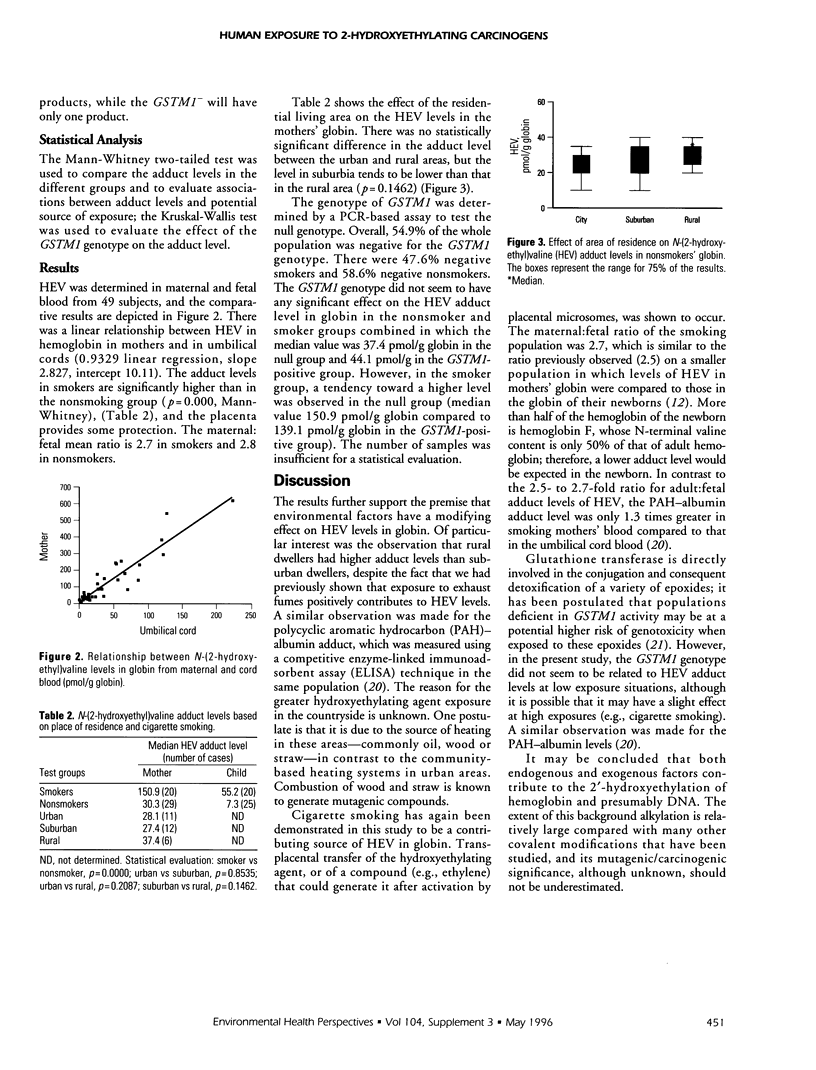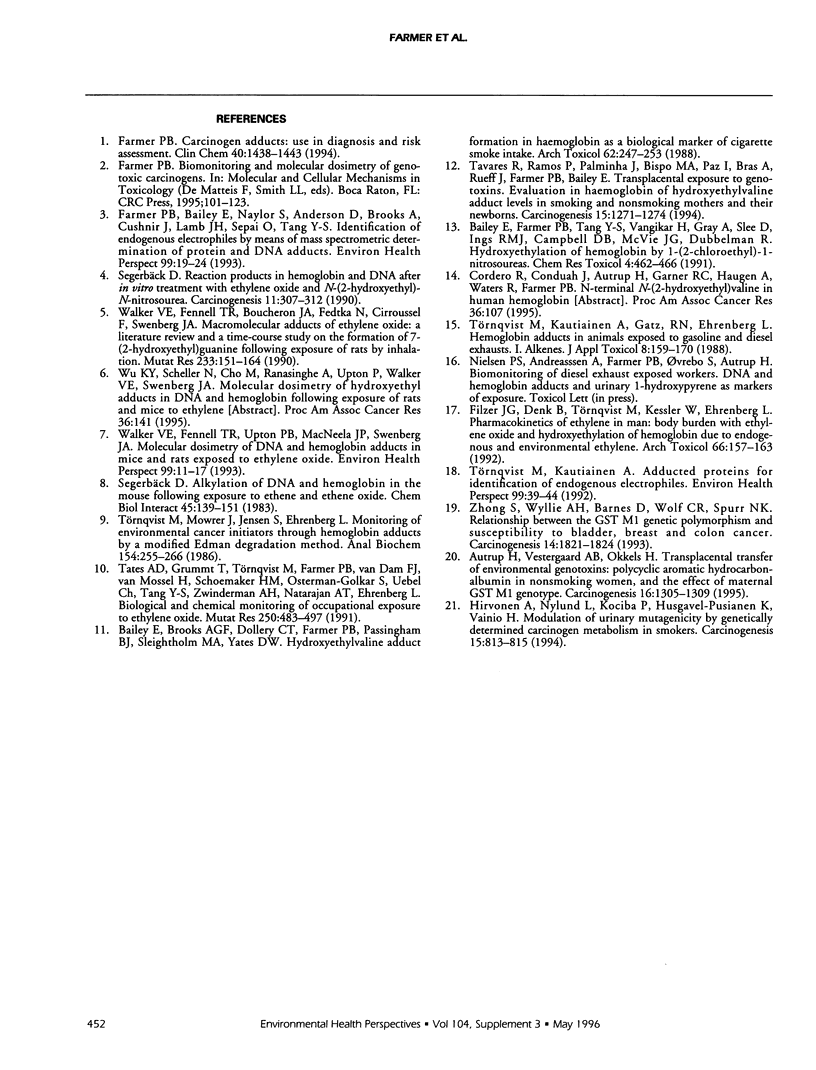Abstract
It is known that human hemoglobin contains low levels of N-terminal N-(2-hydroxyethyl)valine. Possible sources of this modified amino acid are exposure to ethylene oxide or other 2-hydroxy-ethylating agents. Although such processes are likely to occur endogenously, the exogenous contribution to the adduct formation is unclear. In order to explore the latter, we have analyzed N-(2-hydroxyethyl)valine in the globin of 49 pregnant women and evaluated the effect of smoking status, area of residence, and glutathione S-transferase M1 genotype on adduct levels. Transplacental transfer of hydroxyethylating agents was also studied by the analysis of umbilical cord hemoglobin. The adduct levels in smokers were significantly higher than those in nonsmokers. The adduct levels in umbilical cord blood globin were quantitatively related to those in maternal blood (maternal:fetal ratio 2.7 in smokers and 2.8 in nonsmokers). In the nonsmokers, there was no statistically significant difference in the adduct level between the urban and rural areas, but the level in suburbia tended to be lower than that in the rural area. In the combined smoker and nonsmoker groups, there was no effect of the glutathione S-transferase M1 genotype on levels of N-(2-hydroxyethyl)valine.
Full text
PDF



Selected References
These references are in PubMed. This may not be the complete list of references from this article.
- Autrup H., Vestergaard A. B., Okkels H. Transplacental transfer of environmental genotoxins: polycyclic aromatic hydrocarbon-albumin in non-smoking women, and the effect of maternal GSTM1 genotype. Carcinogenesis. 1995 Jun;16(6):1305–1309. doi: 10.1093/carcin/16.6.1305. [DOI] [PubMed] [Google Scholar]
- Bailey E., Brooks A. G., Dollery C. T., Farmer P. B., Passingham B. J., Sleightholm M. A., Yates D. W. Hydroxyethylvaline adduct formation in haemoglobin as a biological monitor of cigarette smoke intake. Arch Toxicol. 1988;62(4):247–253. doi: 10.1007/BF00332482. [DOI] [PubMed] [Google Scholar]
- Bailey E., Farmer P. B., Tang Y. S., Vangikar H., Gray A., Slee D., Ings R. M., Campbell D. B., McVie J. G., Dubbelman R. Hydroxyethylation of hemoglobin by 1-(2-chloroethyl)-1-nitrosoureas. Chem Res Toxicol. 1991 Jul-Aug;4(4):462–466. doi: 10.1021/tx00022a010. [DOI] [PubMed] [Google Scholar]
- Farmer P. B., Bailey E., Naylor S., Anderson D., Brooks A., Cushnir J., Lamb J. H., Sepai O., Tang Y. S. Identification of endogenous electrophiles by means of mass spectrometric determination of protein and DNA adducts. Environ Health Perspect. 1993 Mar;99:19–24. doi: 10.1289/ehp.939919. [DOI] [PMC free article] [PubMed] [Google Scholar]
- Farmer P. B. Carcinogen adducts: use in diagnosis and risk assessment. Clin Chem. 1994 Jul;40(7 Pt 2):1438–1443. [PubMed] [Google Scholar]
- Filser J. G., Denk B., Törnqvist M., Kessler W., Ehrenberg L. Pharmacokinetics of ethylene in man; body burden with ethylene oxide and hydroxyethylation of hemoglobin due to endogenous and environmental ethylene. Arch Toxicol. 1992;66(3):157–163. doi: 10.1007/BF01974008. [DOI] [PubMed] [Google Scholar]
- Hirvonen A., Nylund L., Kociba P., Husgafvel-Pursiainen K., Vainio H. Modulation of urinary mutagenicity by genetically determined carcinogen metabolism in smokers. Carcinogenesis. 1994 May;15(5):813–815. doi: 10.1093/carcin/15.5.813. [DOI] [PubMed] [Google Scholar]
- Segerbäck D. Alkylation of DNA and hemoglobin in the mouse following exposure to ethene and ethene oxide. Chem Biol Interact. 1983 Jul 15;45(2):139–151. doi: 10.1016/0009-2797(83)90064-9. [DOI] [PubMed] [Google Scholar]
- Segerbäck D. Reaction products in hemoglobin and DNA after in vitro treatment with ethylene oxide and N-(2-hydroxyethyl)-N-nitrosourea. Carcinogenesis. 1990 Feb;11(2):307–312. doi: 10.1093/carcin/11.2.307. [DOI] [PubMed] [Google Scholar]
- Tates A. D., Grummt T., Törnqvist M., Farmer P. B., van Dam F. J., van Mossel H., Schoemaker H. M., Osterman-Golkar S., Uebel C., Tang Y. S. Biological and chemical monitoring of occupational exposure to ethylene oxide. Mutat Res. 1991 Sep-Oct;250(1-2):483–497. doi: 10.1016/0027-5107(91)90205-3. [DOI] [PubMed] [Google Scholar]
- Tavares R., Ramos P., Palminha J., Bispo M. A., Paz I., Bras A., Rueff J., Farmer P. B., Bailey E. Transplacental exposure to genotoxins. Evaluation in haemoglobin of hydroxyethylvaline adduct levels in smoking and non-smoking mothers and their newborns. Carcinogenesis. 1994 Jun;15(6):1271–1274. doi: 10.1093/carcin/15.6.1271. [DOI] [PubMed] [Google Scholar]
- Törnqvist M., Kautiainen A. Adducted proteins for identification of endogenous electrophiles. Environ Health Perspect. 1993 Mar;99:39–44. doi: 10.1289/ehp.99-1567046. [DOI] [PMC free article] [PubMed] [Google Scholar]
- Törnqvist M., Kautiainen A., Gatz R. N., Ehrenberg L. Hemoglobin adducts in animals exposed to gasoline and diesel exhausts. 1. Alkenes. J Appl Toxicol. 1988 Jun;8(3):159–170. doi: 10.1002/jat.2550080303. [DOI] [PubMed] [Google Scholar]
- Törnqvist M., Mowrer J., Jensen S., Ehrenberg L. Monitoring of environmental cancer initiators through hemoglobin adducts by a modified Edman degradation method. Anal Biochem. 1986 Apr;154(1):255–266. doi: 10.1016/0003-2697(86)90524-5. [DOI] [PubMed] [Google Scholar]
- Walker V. E., Fennell T. R., Boucheron J. A., Fedtke N., Ciroussel F., Swenberg J. A. Macromolecular adducts of ethylene oxide: a literature review and a time-course study on the formation of 7-(2-hydroxyethyl)guanine following exposures of rats by inhalation. Mutat Res. 1990 Nov-Dec;233(1-2):151–164. doi: 10.1016/0027-5107(90)90159-2. [DOI] [PubMed] [Google Scholar]
- Walker V. E., Fennell T. R., Upton P. B., MacNeela J. P., Swenberg J. A. Molecular dosimetry of DNA and hemoglobin adducts in mice and rats exposed to ethylene oxide. Environ Health Perspect. 1993 Mar;99:11–17. doi: 10.1289/ehp.939911. [DOI] [PMC free article] [PubMed] [Google Scholar]
- Zhong S., Wyllie A. H., Barnes D., Wolf C. R., Spurr N. K. Relationship between the GSTM1 genetic polymorphism and susceptibility to bladder, breast and colon cancer. Carcinogenesis. 1993 Sep;14(9):1821–1824. doi: 10.1093/carcin/14.9.1821. [DOI] [PubMed] [Google Scholar]


